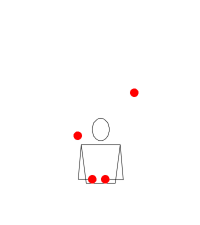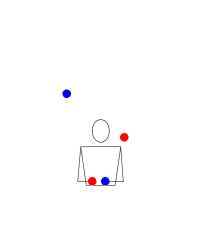| (6,4x)(4x,2) | |
|---|---|
 | |
|
Capacity |
4 |
|
Period |
4 |
|
Full period |
16 |
|
Orbits |
1 |
|
Composition |
Prime |
|
(Ground state) | |
|
(4,4x)(3x,2) | |
|
Self-dual | |
(6,4x)(4x,2) is a synchronous 4 object siteswap where a pair of throws from the 5 object pattern (6,4x)* is followed by a crossing throw at 4 object height, going in the opposite direction. The 6s should be almost three times as high as the 4s, which are the same height as the basic pattern.
There are two versions of this pattern: in the asymmetrical version, all the (6,4x) pairs are thrown toward the same side of the pattern, and in the symmetrical version, (6,4x)(4x,2)(4x,6)(2,4x), or (6,4x)(4x,2)* for short, each 6 is thrown with the hand that didn't just do a 4x.
Siteswap exercises[]
You can use these exercises to practice the same kinds of throws and sequences of throws that are done in this pattern, before you learn the full pattern.
Some of the siteswaps listed below are shortened to leave out parts where you’re not doing anything. Click on them to see animations of the exercises.
You should practice doing these starting with your right hand and with your left hand, so that you will be ready to learn the full symmetrical pattern.
Prerequisites: 4 ball fountain
Exercises to prepare for (6,4x)(4x,2)*:
- 1 ball 4x
- 1 ball 6
- 2 ball (6,4x)
- 2 ball (6,4x)(0,0)(4x,0)
- 3 ball (4x,2)*
- 3 ball (6,4x)(0,2)(4x,2)*
- 4 ball (6,4x)(4x,2)
Variations[]
- (6x,4x)(4,2)
- (6x,4x)(2x,4x)
- (6,4)(4x,2x)
- (6,4)(2,4)
- (6,4x)(2x,0)
- (6,4x)*
- (8,6x)(4x,2)
- (8,6x)(6x,4)



